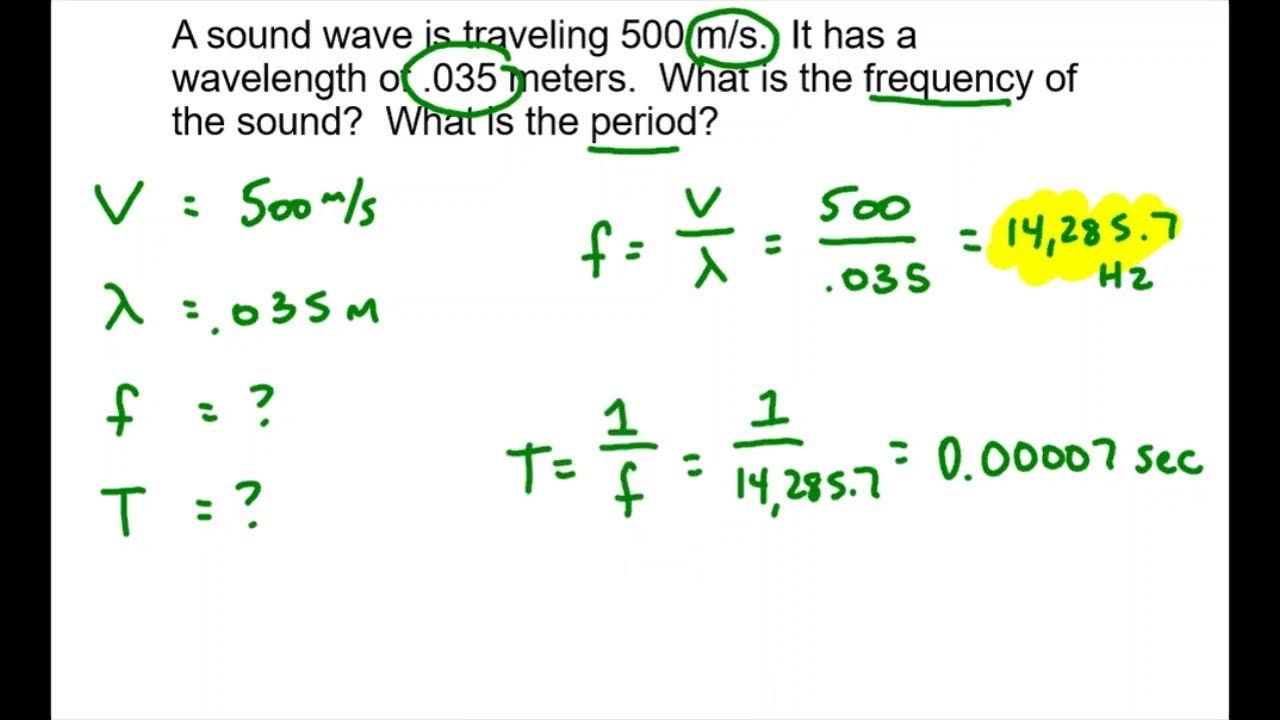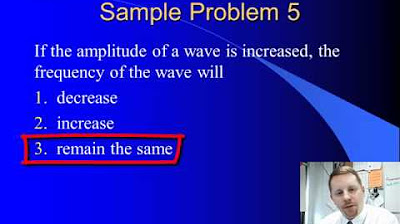Frequency - Period
TLDRThis educational script delves into the fundamental concepts of frequency and period in the context of periodic waves. It explains how frequency is the number of waves passing a point in a unit of time, measured in Hertz, while the period is the time it takes for one wave to pass. The script illustrates these concepts with an ocean wave analogy and establishes the inverse relationship between frequency and period: as frequency increases, the period decreases, and vice versa. It also highlights the immutable nature of frequency and period as a wave travels through different media, emphasizing their importance in characterizing a wave's behavior.
Takeaways
- 🌊 Periodic waves repeat over time, characterized by frequency and period.
- 📈 Frequency measures how many waves pass a point in a given time.
- ⌛ Period is the time it takes for one complete wave cycle.
- 🏄♂️ An example of period: the time to go from one wave crest to the next in the ocean.
- 3️⃣ If frequency is 3 waves per second, it means 3 waves pass a point every second.
- 🔄 The unit of frequency is Hertz (Hz), named after physicist Heinrich Hertz.
- 1️⃣ The relationship between frequency (f) and period (T) is f = 1/T.
- 🔄 Increasing frequency decreases the period, and vice versa.
- 2️⃣ Doubling the frequency halves the period.
- 🔄 Frequency and period remain constant when a wave transitions through different media.
Q & A
What is frequency in the context of periodic waves?
-Frequency is the number of waves that pass a given point in a certain amount of time. It characterizes how often a wave repeats or 'assaults' the medium in that time.
How is the period of a wave defined?
-The period of a wave is the time it takes for one complete wave cycle to pass a given point. It represents the duration for one wave to travel from one crest to the next.
Can you explain the relationship between frequency and period?
-Frequency and period are inversely related. The frequency is equal to 1 divided by the period (Frequency = 1/Period). This means that if the frequency increases, the period decreases, and vice versa.
What is the unit of frequency, and who is it named after?
-The unit of frequency is Hertz (Hz), named after Heinrich Hertz, a physicist who first demonstrated the existence of electromagnetic waves in 1887.
If a wave has a frequency of 3 Hertz, what is its period?
-If a wave has a frequency of 3 Hertz, its period would be 1/3 of a second, meaning it takes a third of a second for one complete wave cycle to occur.
What happens to the period if the frequency of a wave is doubled?
-If the frequency of a wave is doubled, the period is halved. This is because the product of frequency and period must always equal 1.
How do frequency and period behave when a wave passes through different mediums?
-Frequency and period remain constant when a wave passes through different mediums. Other properties of the wave might change, but the frequency and period cannot, as this would cause a buildup of waves at the boundary.
Why can't frequency and period change when a wave crosses a boundary?
-Frequency and period can't change when a wave crosses a boundary because otherwise, the waves would congregate at the boundary, which the boundary cannot sustain.
What is the significance of frequency and period in characterizing waves?
-Frequency and period are fundamental properties that remain constant regardless of the medium through which a wave travels, making them crucial for characterizing and analyzing waves.
What does it mean when a wave has a frequency of 3 waves per second?
-A frequency of 3 waves per second means that three complete waves pass a given point every second. This can also be expressed as a frequency of 3 Hertz.
Outlines
🌊 Understanding Frequency and Period of Waves
This paragraph introduces the fundamental concepts of frequency and period in the context of periodic waves. Frequency is defined as the number of waves passing a specific point within a unit of time, which characterizes how often the wave 'assaults' the medium. The period, conversely, is the duration it takes for one complete wave cycle to occur. An analogy of being on a boat in the ocean helps to visualize the period as the time between reaching successive wave crests. The paragraph also explains the relationship between frequency and period, stating that frequency equals one over the period. This relationship is fundamental and unchanging, regardless of the medium through which the wave travels.
Mindmap
Keywords
💡Frequency
💡Period
💡Periodic Waves
💡Hertz
💡Wave Cycle
💡Crest
💡Electromagnetic Waves
💡Boundary
💡Propagation
💡Characteristic
💡Congregate
Highlights
Frequency and period are fundamental properties of periodic waves.
Frequency is the number of waves passing a point in a given time.
Period is the time taken for one wave to pass a point.
An analogy for period is the time from crest to crest of an ocean wave.
Frequency is measured in Hertz, named after physicist Heinrich Hertz.
The relationship between frequency and period is given by frequency = 1/period.
Increasing frequency results in a decrease in period, and vice versa.
Doubling the frequency halves the period, and halving the frequency doubles the period.
Frequency and period are invariant properties of a wave as it travels through different media.
The invariance of frequency and period is crucial for characterizing waves.
Waves cannot accumulate at boundaries due to the constancy of frequency and period.
Periodic waves are characterized by their unchanging frequency and period, regardless of external conditions.
Understanding frequency and period is essential for the study of periodic waves.
The relationship between frequency and period is a fundamental concept in wave physics.
The analogy of ocean waves helps in understanding the concept of period.
Hertz's contribution to the representation of electromagnetic waves is significant.
The mathematical relationship between frequency and period is always applicable.
Transcripts
5.0 / 5 (0 votes)
Thanks for rating:





